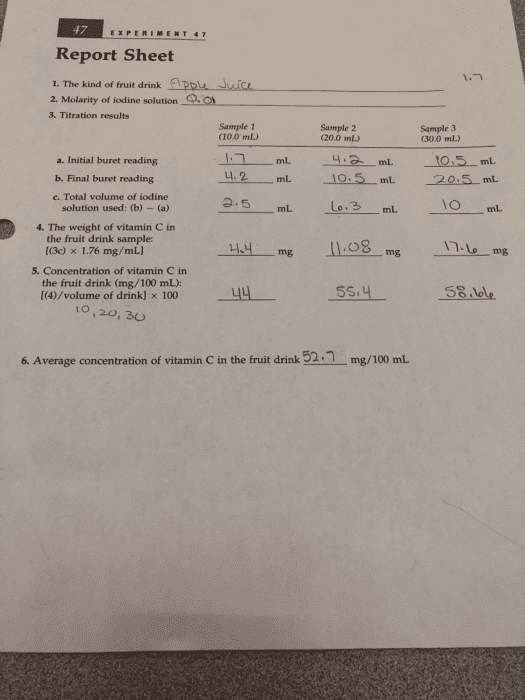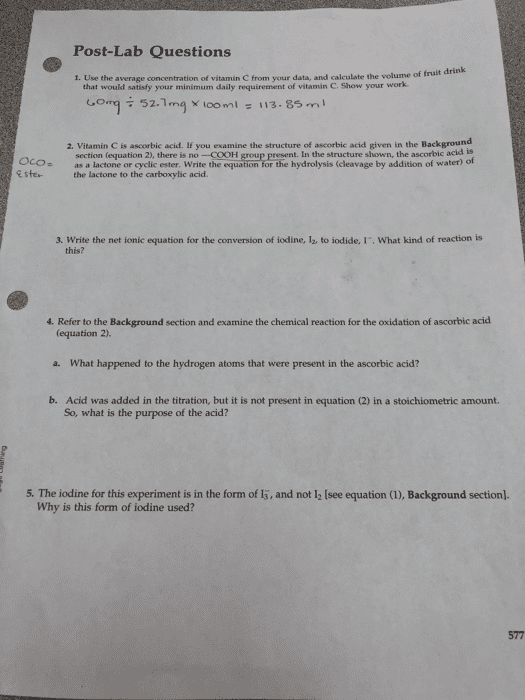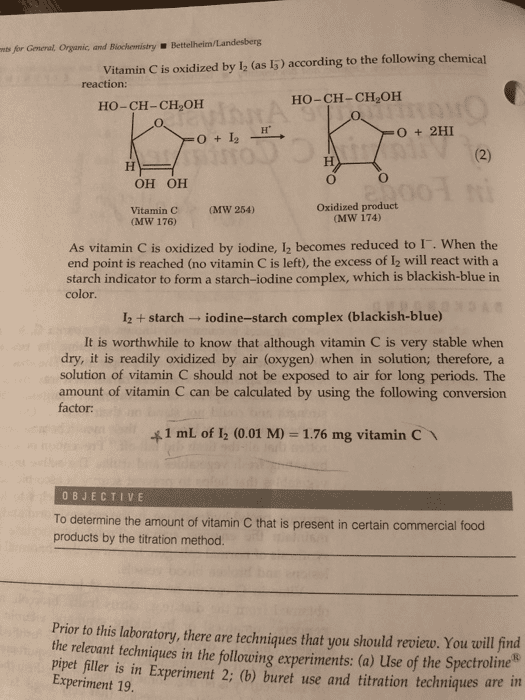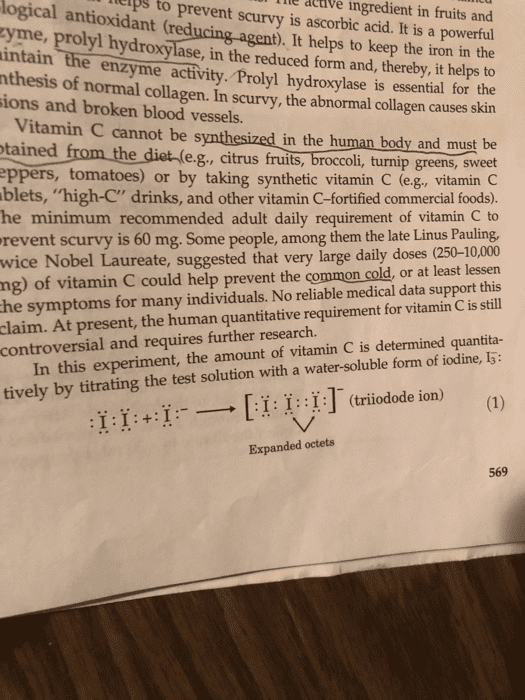CHM 1360 Spring 2021 Name __________________________
Lab 1 Buffers Worksheet
Type your answers to the following questions. Make sure to use complete sentences. For images that need to be hand drawn, take a digital picture of your image and insert it into your worksheet.
- (0.5 point) Insert your lab notebook image of the pH plot from your preparation of the acetate buffer.
- (1.5 point) Draw the Lewis structures for acetic acid (CH3COOH) and acetate (CH3COO-). On each structure, label the carboxylic acid or carboxylate functional group. Also, label the acidic hydrogen (if it has one).
- (2 points) In the first experiment, you prepared a buffer by combining solutions of acetic acid and sodium acetate.
- (1 point) Write the chemical equation for the equilibrium of acetic acid and acetate in water. Include the states of the reactants.
- (1 point) Write a net ionic equation that shows how this buffer neutralizes added acid (HCl).
- (1 point) Write a net ionic equation that shows how this buffer neutralizes added base (NaOH).
- In the second part of Experiment 1, you added water to the buffer solution which diluted it by a factor of two.
- (1 point) Write the chemical equation for the equilibrium of acetic acid and acetate in water. Include the states of the reactants.
- (0.5 point) Did the pH of the solution change? Briefly explain your observation.
- (0.5 point) Which buffer solution would have a greater buffer capacity, your acetate buffer before the extra water was added, or the buffer solution that had been diluted? Explain.
- (0.5 point) For your diluted acetate buffer, if you then added 50 mL of 0.50 M H2SO4 to the solution how would you expect the pH to change? Explain your answer.
- (1 point) Which of the following could be added to a solution of monobasic dihydrogen phosphate (KH2PO4) to produce a buffer? Briefly explain your answer(s).
Dibasic monohydrogen phosphate hydrochloric acid sodium chloride
- A) hydrochloric acid only
- B) sodium chloride only
- C) Dibasic monohydrogen phosphate (K2HPO4) only
- D) Dibasic monohydrogen phosphate (K2HPO4) and sodium chloride
- (a) (1 point) The average human contains 5.0 liters of blood having a pH of 7.35. Calculate the number of moles of H3O+ at 25 o (Report the correct number of SigFigs in your final answers).
(b) (1 point) If a person’s blood pH falls to 7.25, how many more moles of H3O+ are present at 25 oC?
- (a) (0.5 point) Write a chemical equation to summarize what was happening in the phenol red solution in the flask in Experiment 2.
(b) (0.5 point) Does exhaling CO2 help raise or lower the pH of the blood? Explain, using the equation you wrote for part (a).
(c) (0.5 point) What happens to the position of the equilibrium and pH when blood absorbs added base?
- (1 point) At pH 3.0, the amino acid glycine has the structure shown here. Draw the structure of this molecule at pH 12.0.
CHM 1360 Spring 2021 Name __________________________
Lab 1 Buffers Worksheet
Type your answers to the following questions. Make sure to use complete sentences. For images that need to be hand drawn, take a digital picture of your image and insert it into your worksheet.
- (0.5 point) Insert your lab notebook image of the pH plot from your preparation of the acetate buffer.
- (1.5 point) Draw the Lewis structures for acetic acid (CH3COOH) and acetate (CH3COO-). On each structure, label the carboxylic acid or carboxylate functional group. Also, label the acidic hydrogen (if it has one).
- (2 points) In the first experiment, you prepared a buffer by combining solutions of acetic acid and sodium acetate.
- (1 point) Write the chemical equation for the equilibrium of acetic acid and acetate in water. Include the states of the reactants.
- (1 point) Write a net ionic equation that shows how this buffer neutralizes added acid (HCl).
- (1 point) Write a net ionic equation that shows how this buffer neutralizes added base (NaOH).
- In the second part of Experiment 1, you added water to the buffer solution which diluted it by a factor of two.
- (1 point) Write the chemical equation for the equilibrium of acetic acid and acetate in water. Include the states of the reactants.
- (0.5 point) Did the pH of the solution change? Briefly explain your observation.
- (0.5 point) Which buffer solution would have a greater buffer capacity, your acetate buffer before the extra water was added, or the buffer solution that had been diluted? Explain.
- (0.5 point) For your diluted acetate buffer, if you then added 50 mL of 0.50 M H2SO4 to the solution how would you expect the pH to change? Explain your answer.
- (1 point) Which of the following could be added to a solution of monobasic dihydrogen phosphate (KH2PO4) to produce a buffer? Briefly explain your answer(s).
Dibasic monohydrogen phosphate hydrochloric acid sodium chloride
- A) hydrochloric acid only
- B) sodium chloride only
- C) Dibasic monohydrogen phosphate (K2HPO4) only
- D) Dibasic monohydrogen phosphate (K2HPO4) and sodium chloride
- (a) (1 point) The average human contains 5.0 liters of blood having a pH of 7.35. Calculate the number of moles of H3O+ at 25 o (Report the correct number of SigFigs in your final answers).
(b) (1 point) If a person’s blood pH falls to 7.25, how many more moles of H3O+ are present at 25 oC?
- (a) (0.5 point) Write a chemical equation to summarize what was happening in the phenol red solution in the flask in Experiment 2.
(b) (0.5 point) Does exhaling CO2 help raise or lower the pH of the blood? Explain, using the equation you wrote for part (a).
(c) (0.5 point) What happens to the position of the equilibrium and pH when blood absorbs added base?
- (1 point) At pH 3.0, the amino acid glycine has the structure shown here. Draw the structure of this molecule at pH 12.0.






